输尿管支架细菌生物膜观察及病原菌分布和耐药性
导尿管伴随尿路感染菌群分布及耐药性分析
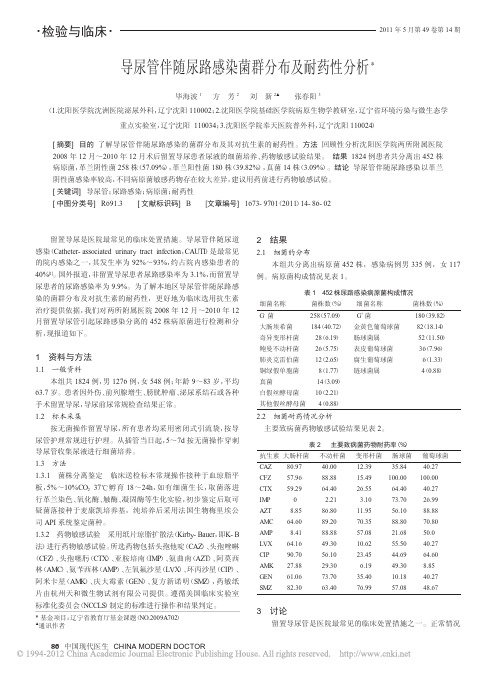
2011年5月第49卷第14期导尿管伴随尿路感染菌群分布及耐药性分析*毕海波1方芳2刘新2▲张春阳3(1.沈阳医学院沈洲医院泌尿外科,辽宁沈阳110002;2.沈阳医学院基础医学院病原生物学教研室,辽宁省环境污染与微生态学重点实验室,辽宁沈阳110034;3.沈阳医学院奉天医院普外科,辽宁沈阳110024)[摘要]目的了解导尿管伴随尿路感染的菌群分布及其对抗生素的耐药性。
方法回顾性分析沈阳医学院两所附属医院2008年12月~2010年12月术后留置导尿患者尿液的细菌培养、药物敏感试验结果。
结果1824例患者共分离出452株病原菌,革兰阴性菌258株(57.09%),革兰阳性菌180株(39.82%),真菌14株(3.09%)。
结论导尿管伴随尿路感染以革兰阴性菌感染率较高,不同病原菌敏感药物存在较大差异,建议用药前进行药物敏感试验。
[关键词]导尿管;尿路感染;病原菌;耐药性[中图分类号]R691.3[文献标识码]B[文章编号]1673-9701(2011)14-86-02留置导尿是医院最常见的临床处置措施。
导尿管伴随尿道感染(Catheter-associated urinary tract infection,CAUTI)是最常见的院内感染之一,其发生率为92%~93%,约占院内感染患者的40%[1]。
国外报道,非留置导尿患者尿路感染率为3.1%,而留置导尿患者的尿路感染率为9.9%。
为了解本地区导尿管伴随尿路感染的菌群分布及对抗生素的耐药性,更好地为临床选用抗生素治疗提供依据,我们对两所附属医院2008年12月~2010年12月留置导尿管引起尿路感染分离的452株病原菌进行检测和分析,现报道如下。
1资料与方法1.1一般资料本组共1824例,男1276例,女548例;年龄9~83岁,平均63.7岁。
患者因外伤、前列腺增生、膀胱肿瘤、泌尿系结石或各种手术留置导尿,导尿前尿常规检查结果正常。
1.2标本采集按无菌操作留置导尿,所有患者均采用密闭式引流袋,按导尿管护理常规进行护理。
留置尿管相关性尿路感染的病原菌分布及耐药性分析_张晓红
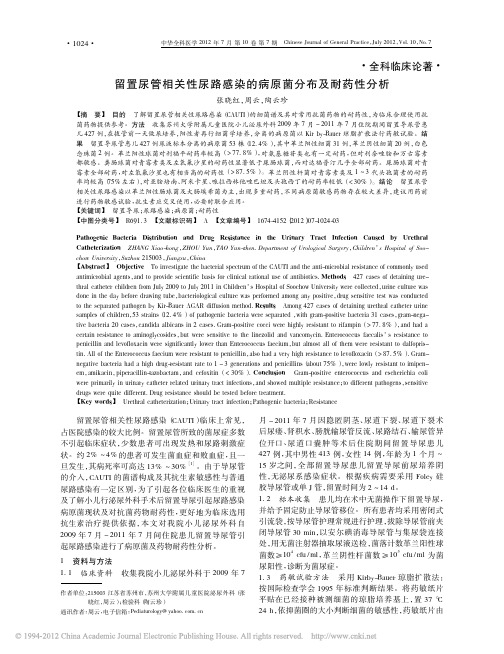
·全科临床论著·留置尿管相关性尿路感染的病原菌分布及耐药性分析张晓红,周云,陶云珍【摘要】目的了解留置尿管相关性尿路感染(CAUTI)的细菌谱及其对常用抗菌药物的耐药性,为临床合理使用抗菌药物提供参考。
方法收集苏州大学附属儿童医院小儿泌尿外科2009年7月-2011年7月住院期间留置导尿管患儿427例,在拔管前一天做尿培养,阳性者再行细菌学培养,分离的病原菌以Kir by-Bauer琼脂扩散法行药敏试验。
结果留置导尿管患儿427例尿液标本分离的病原菌53株(12.4%),其中革兰阳性细菌31例,革兰阴性细菌20例,白色念珠菌2例。
革兰阳性球菌对利福平耐药率较高(>77.8%),对氨基糖苷类也有一定耐药,但对利奈唑胺和万古霉素都敏感。
粪肠球菌对青霉素类及左氧氟沙星的耐药性显著低于屎肠球菌,而对达福普汀几乎全部耐药。
屎肠球菌对青霉素全部耐药,对左氧氟沙星也有相当高的耐药性(>87.5%)。
革兰阴性杆菌对青霉素类及1 3代头孢菌素的耐药率均较高(75%左右),对亚胺培南、阿米卡星、哌拉西林他唑巴坦及头孢西丁的耐药率较低(<30%)。
结论留置尿管相关性尿路感染以革兰阳性肠球菌及大肠埃希菌为主,出现多重耐药,不同病原菌敏感药物存在较大差异,建议用药前进行药物敏感试验,抗生素应交叉使用,必要时联合应用。
【关键词】留置导尿;尿路感染;病原菌;耐药性【中图分类号】R691.3【文献标识码】A【文章编号】1674-4152(2012)07-1024-03Pathogenic Bacteria Distribution and Drug Resistance in the Urinary Tract Infection Caused by Urethral Catheterization ZHANG Xiao-hong,ZHOU Yun,TAO Yun-zhen.Department of Urological Surgery,Children’s Hospital of Soo-chow University,Suzhou215003,Jiangsu,China【Abstract】Objective To investigate the bacterial spectrum of the CAUTI and the anti-microbial resistance of commonly used antimicrobial agents,and to provide scientific basis for clinical rational use of antibiotics.Methods427cases of detaining ure-thral catheter children from July2009to July2011in Children’s Hospital of Soochow University were collected,urine culture was done in the day before drawing tube,bacteriological culture was performed among any positive,drug sensitive test was conductedto the separated pathogen by Kir-Bauer AGAR diffusion method.Results Among427cases of detaining urethral catheter urine samples of children,53strains(12.4%)of pathogenic bacteria were separated,with gram-positive bacteria31cases,gram-nega-tive bacteria20cases,candida albicans in2cases.Gram-positive cocci were highly resistant to rifampin(>77.8%),and had a certain resistance to aminoglycosides,but were sensitive to the linezolid and vancomycin.Enterococcus faecalis’s resistance to penicillin and levofloxacin were significantly lower than Enterococcus faecium,but almost all of them were resistant to dalfopris-tin.All of the Enterococcus faecium were resistant to penicillin,also had a very high resistance to levofloxacin(>87.5%).Gram-negative bacteria had a high drug-resistant rate to1-3generations and penicillins(about75%),were lowly resistant to imipen-em,amikacin,piperacillin-tazobactam,and cefoxitin(<30%).Conclusion Gram-positive enterococcus and escherichia coli were primarily in urinary catheter related urinary tract infections,and showed multiple resistance;to different pathogens,sensitive drugs were quite different.Drug resistance should be tested before treatment.【Key words】Urethral catheterization;Urinary tract infection;Pathogenic bacteria;Resistance留置尿管相关性尿路感染(CAUTI)临床上常见,占医院感染的较大比例。
不同输尿管支架对尿路感染患者的影响及病原学分析

・
论 著 ・
不 同输 尿 管 支架 对 尿 路 感 染 患 者 的 影 响及 病 原 学 分 析
张杰 ,王 强 ,曹彩琴
( 武汉科技 大学 附属 天佑 医院介人 科 , 湖北 武汉 4 3 0 0 6 4 )
摘 要 :目的 考 。方 法
探 讨 不 同 输 尿 管 支 架对 患 者 尿 路 感 染 率 的 影 响 , 并 分析 尿路感 染病 原学 特点 , 为 临 床 诊 治 提 供 参 选择 2 0 1 1年 5月 一 2 0 1 4年 8月 2 8 6例术 后输 尿 管 实施 留 置 支 架 导 管 的 患 者 , 按 照 输 尿 管 类 型 分 为 进
Ab s t r a c t :OB J 『 ECT I VE To i n v e s t i g a t e i n f l u e n c e o f d i f f e r e n t u r e t e r a l s t e n t s f o r u r i n a r y t r a c t i n f e c t i o n s a n d i t s e t i o — l o g i c a l c h a r a c t e r i s t i c s ,S O a s t o p r o v i d e a r e f e r e n c e f o r c l i n i c a l t r e a t me n t . M ET HODS Fr o m Ma y 2 0 1 1 t o Au g . 2 0 1 4,a t o t a l o f 2 8 6 c a s e s o f p a t i e n t s wi t h p o s t o p e r a t i v e i n d we l l i n g u r e t e r a l s t e n t s we r e s e l e c t e d a n d d i v i d e d a e —
尿液培养病原菌的分布及耐药性分析

治疗 泌尿系感染 提供科 学依据 。笔 者对本 院 2 0 0 8 年2 月一 2 0 1 0 年1 1月的 4 5 1 份尿液标本 中分离 的 1 0 5株病原 菌及 其耐药性进
行 了分析 ,现报道如下 。 1 资料与方法 l _ 1 标本采集
1 0 5株病原菌 来 自笔 者所在 医院住 院和门诊患者 于 2 0 0 8 年
《 中 外 医 学 研 究》 第1 1 卷第1 1 期( 总 第1 9 9 )  ̄ J ) 2 0 1 3 & l z 4  ̄ 医技与临历 Y i j i y u l i n c h u a n g
尿液培 养病原 菌 的分布及 耐药性分析
吴 尚文①
【 关键词 】 尿液培养 ; 病原 菌 ; 耐药性
2月 一 2 0 1 0年 1 1 月清晨 清洁 的中段 尿或无 菌导 出的尿液 ,严格
参《 全 国临床检 验操作 规程第 3 版 》相关 标准对 尿液进 行分离 培养 ” 。
1 . 2 培养方法 医护人员取 完患者 尿液后 ,检验人员 第一 时间对尿 液标本
进行检 验 ,吸取 1 0 l 尿 液标本 于培养皿 中划 线接种 ,接种完
一
Ch i n e s e a n d F o mi g n Me d i c a l R e s e a mh V o 1 . 1 1 , N O . 1 1 A p r , 2 0 1 3
35—
医技与临. 床 Y i j i y u l i n c h u a n g 《 中 外 医 学 研 究》 第1 1 卷第l 1 期( 总 第1 9 9 期 ) 2 0 l 3 年4 月
两种标本处理方法对 电化 学发光 法测定 甲状腺激素 影 响 的观 察
导尿管伴随尿路感染的菌群及其耐药性分析

者均采用密闭式引流袋 ,按导尿管护理常规进行护
理 ,从留置导 尿管 当 日起 ,3 d 、1 后按无 、7d 4 d 菌操作 穿刺导 尿管收 集尿 液送细 菌培 养 。
较严重, 其产酶率分别为5 . 和 4 . 。 98 % 74 常见革兰 %
阳性 菌和 革兰阴性 菌的耐 药情况 分别见 表 2、表 3。
第 38卷 第 6期 20 O 8年 1 1月
温
州
医
学
院
学
报
Vo . 8 N O 6 13 . NO 2 8 V. 00
J u n lo e z u M e i a le e o r a f W n ho d c lCo l g
床 经
导尿管伴随尿路感染的菌群及其耐药性分析
1 材料和方法
11 一般资料 .
本组共 1 6 例 ,男 1 6 例 ,女 7 5 3 1
44 , 龄 1- 2 ,平均 6 . 岁 。因前 列腺增 0例 年 6 ̄9 岁 - 27 生 症 、膀胱 肿瘤 、泌尿 系结 石 、泌 尿 系外伤等疾病 需 要 留置导 尿管 3d及 以上 ,留置导尿 管前尿 常规 检 查正常 。 1 2 标 本收集 . 按 无菌 操作 留置 导尿管 ,所 有患 22 药敏试验 . 耐 甲氧西林金 黄色 葡萄球菌和耐 甲 氧西林表皮葡萄球菌的分离率分别达到5 . 和8 .o 47 82 。 % 7 大肠埃 希菌 和肺 炎克雷 伯菌 产超 广谱 / 内酰 胺酶 3一
例留置导尿管患者尿液 的细 菌学培 养情况 ( 离的病原 菌进行 K r yB u r 分 i b —a e 琼脂扩散 法药敏 试验 ) 。结果 :
分离的病原 菌 3 6 ,阳性率达 2 .% 7株 4 o ;其中革 兰阴性细 菌占5 .% 6 2 ;大肠埃希 菌和肺 炎克雷伯菌产超广
急诊留观室导尿管相关性尿路感染病原菌分布、耐药性及防范
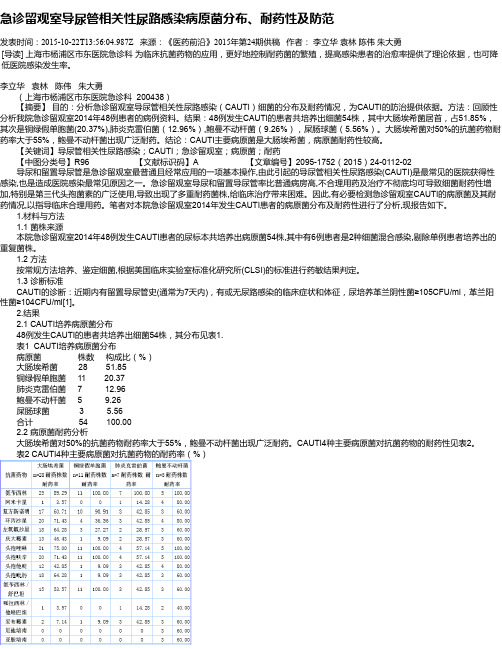
急诊留观室导尿管相关性尿路感染病原菌分布、耐药性及防范发表时间:2015-10-22T13:56:04.987Z 来源:《医药前沿》2015年第24期供稿作者:李立华袁林陈伟朱大勇[导读] 上海市杨浦区市东医院急诊科为临床抗菌药物的应用,更好地控制耐药菌的繁殖,提高感染患者的治愈率提供了理论依据,也可降低医院感染发生率。
李立华袁林陈伟朱大勇(上海市杨浦区市东医院急诊科 200438)【摘要】目的:分析急诊留观室导尿管相关性尿路感染(CAUTI)细菌的分布及耐药情况,为CAUTI的防治提供依据。
方法:回顾性分析我院急诊留观室2014年48例患者的病例资料。
结果:48例发生CAUTI的患者共培养出细菌54株,其中大肠埃希菌居首,占51.85%,其次是铜绿假单胞菌(20.37%),肺炎克雷伯菌(12.96%),鲍曼不动杆菌(9.26%),屎肠球菌(5.56%)。
大肠埃希菌对50%的抗菌药物耐药率大于55%,鲍曼不动杆菌出现广泛耐药。
结论:CAUTI主要病原菌是大肠埃希菌,病原菌耐药性较高。
【关键词】导尿管相关性尿路感染;CAUTI;急诊留观室;病原菌;耐药【中图分类号】R96 【文献标识码】A 【文章编号】2095-1752(2015)24-0112-02导尿和留置导尿管是急诊留观室最普通且经常应用的一项基本操作,由此引起的导尿管相关性尿路感染(CAUTI)是最常见的医院获得性感染,也是造成医院感染最常见原因之一。
急诊留观室导尿和留置导尿管率比普通病房高,不合理用药及治疗不彻底均可导致细菌耐药性增加,特别是第三代头孢菌素的广泛使用,导致出现了多重耐药菌株,给临床治疗带来困难。
因此,有必要检测急诊留观室CAUTI的病原菌及其耐药情况,以指导临床合理用药。
笔者对本院急诊留观室2014年发生CAUTI患者的病原菌分布及耐药性进行了分析,现报告如下。
1.材料与方法1.1 菌株来源本院急诊留观室2014年48例发生CAUTI患者的尿标本共培养出病原菌54株,其中有6例患者是2种细菌混合感染,剔除单例患者培养出的重复菌株。
小儿长期留置导尿管常见病原菌监测及耐药性分析
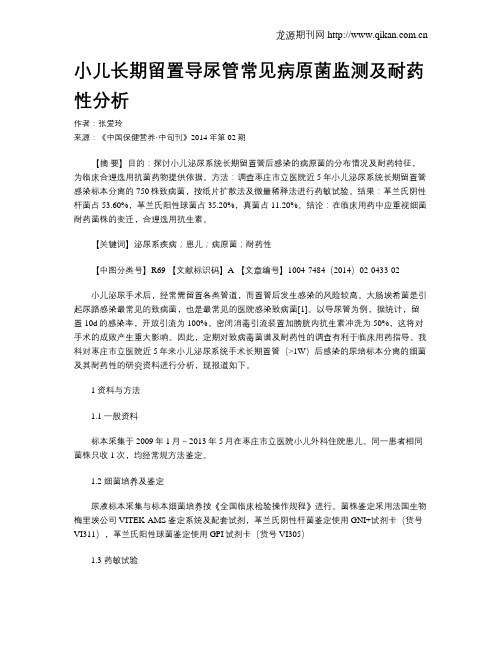
小儿长期留置导尿管常见病原菌监测及耐药性分析作者:张爱玲来源:《中国保健营养·中旬刊》2014年第02期【摘要】目的:探讨小儿泌尿系统长期留置管后感染的病原菌的分布情况及耐药特征,为临床合理选用抗菌药物提供依据。
方法:调查枣庄市立医院近5年小儿泌尿系统长期留置管感染标本分离的750株致病菌,按纸片扩散法及微量稀释法进行药敏试验。
结果:革兰氏阴性杆菌占53.60%,革兰氏阳性球菌占35.20%,真菌占11.20%。
结论:在临床用药中应重视细菌耐药菌株的变迁,合理选用抗生素。
【关键词】泌尿系疾病;患儿;病原菌;耐药性【中图分类号】R69 【文献标识码】A 【文章编号】1004-7484(2014)02-0433-02小儿泌尿手术后,经常需留置各类管道,而置管后发生感染的风险较高。
大肠埃希菌是引起尿路感染最常见的致病菌,也是最常见的医院感染致病菌[1]。
以导尿管为例,据统计,留置10d的感染率,开放引流为100%,密闭消毒引流装置加膀胱内抗生素冲洗为50%,这将对手术的成败产生重大影响。
因此,定期对致病毒菌谱及耐药性的调查有利于临床用药指导。
我科对枣庄市立医院近5年来小儿泌尿系统手术长期置管(>1W)后感染的尿培标本分离的细菌及其耐药性的研究资料进行分析,现报道如下。
1 资料与方法1.1 一般资料标本采集于2009年1月~2013年5月在枣庄市立医院小儿外科住院患儿。
同一患者相同菌株只收1次,均经常规方法鉴定。
1.2 细菌培养及鉴定尿液标本采集与标本细菌培养按《全国临床检验操作规程》进行。
菌株鉴定采用法国生物梅里埃公司VITEK-AMS鉴定系统及配套试剂,革兰氏阴性杆菌鉴定使用GNI+试剂卡(货号VI311),革兰氏阳性球菌鉴定使用GPI试剂卡(货号VI305)1.3 药敏试验采用Kerby-Bauer 纸片扩散法,纸片均为中国药品生物制品检定所产品。
1996年1月后采用微量稀释法进行药敏试验,所有试剂均来自Becton A.。
导尿管相关性尿路感染的病原菌分布及耐药性

中华医院感染学杂志2012年第22卷第4期 Chin J Nosocomiol Vol.22No.4 2012
·论 著·
导尿管相关性尿路感染的病原菌分布及耐药性
程 光 敏1 ,姜 玲2 ,尧 兴 水2
(1.湖北省崇阳县人民医院设备科 2.检验科,湖北 崇阳县 437500)
摘要:目的 了解医院导尿管相关性尿路感染的病原菌 分 布 及 耐 药 特 征 ,为 临 床 医 师 合 理 使 用 抗 菌 药 物 提 供 参 考依 据。 方 法 严 格 按 照 《全 国 临 床 检 验 操 作 规 程》,采 集 患 者 的 尿 液 进 行 细 菌 培 养 与 鉴 定 ;采 用 CLSI推 荐 的 K-B法进行药敏试验。结果 159 株 尿 路 感 染 病 原 菌 以 大 肠 埃 希 菌 为 主 ,占 38.4%,铜 绿 假 单 胞 菌 第 2 位,占 13.2%,凝固酶阴性葡萄球菌第3位,占12.6%;所有病原菌对常用抗菌 药 物 均 产 生 了 不 同 的 耐 药 性 。 结 论 临 床 医 师 应 重 视 病 原 学 监 测 ,按 照 药 敏 试 验 结 果 规 范 用 药 ,才 能 有 效 控 制 导 尿 管 相 关 性 尿 路 感 染 ,提 高 临 床 治 愈 率 。 关 键 词 :导 尿 管 相 关 性 尿 路 感 染 ;病 原 菌 ;构 成 比 ;耐 药 性 中 图 分 类 号 :R378 文 献 标 识 码 :A 文 章 编 号 :1005-4529(2012)04-0854-02
2 结 果
收稿日期:2011-09-25 ; 修回日期:2011-10-30
2.1 尿 路 感 染 病 原 菌 159 株 病 原 菌 以 大 肠 埃 希
中华医院感染学杂志2012年第22卷第4期 Chin J Nosocomiol Vol.22No.4 2012
导尿管相关性尿路感染的病原菌分布及耐药性(2)

2 结 果
2.1 感染率及病原菌分 布 留 置 导 尿 管 >48h 的 2226例妇科手术患者中,发生留 置 导 尿 相 关 的 尿 路 感染 89 例,感 染 率 为 4.00%。 共 分 离 出 103 株 病 原 菌 ,其 分 布 构 成 比 见 表 1。
表 1 尿 路 感 染 病 原 菌 的 分 布 构 成 比 (% ) Table 1 Distribution of the pathogens causing
1 资 料 与 方 法
1.1 研究 资 料 2009 年 1 月 -2010 年 12 月 我 院
收稿日期:2012-04-11 ; 修回日期:2012-05-20
妇科留置 导 尿 相 关 尿 路 感 染 患 者 89 例,年 龄 39~ 83岁,平均61岁,置管时间2~17d。 质控菌株:铜 绿 假 单 胞 菌 ATCC 27853、大 肠 埃 希 菌 ATCC 25922、金黄色 葡 萄 球 菌 ATCC 25923 由 中 国 医 学 菌种保藏 中 心 提 供。 药 品 纸 片 购 自 英 国 Oxoid 公 司。 1.2 仪 器 与 试 剂 哥 伦 比 亚 琼 脂、M-H 琼 脂, VITEK-60全自动 微 生 物 分 析 仪、革 兰 阴 性 菌 及 革 兰阳性菌鉴定卡、药 敏 卡 均 购 自 法 国 生 物 梅 里 埃 公 司。 1.3 细菌鉴定与药 敏 试 验 按 临 床 检 验 管 理 与 技 术规程进行分离 培 养,病 原 菌 由 仪 器 VITEK-60 鉴
中华医院感染学杂志2012年第22卷第15期 Chin J Nosocomiol Vol.22No.15 2012
· 3411 ·
·论 著·
导尿管相关性尿路感染的病原菌分布及耐药性
细菌生物膜与留置双J管相关尿路感染的观察

[ 7 ] 韩涛 , 肖军 章 . 软 件 面 积 测 算 法 评 定 阿 霉 素 椎 旁 治 疗 带 状疱疹后 神 经 痛 的疗 效 研 究 [ J ] . 医 学 理论 与 实践 ,
a my c i n s e ns o r y g a ngl i on e c t om y: n o ve l a pp r o a c h f o r
并且 , 从我 们选 取病 例 的治疗 过 程 中我们 发 现 , 阿霉 素脊 神经 后 根毁 损 , 是 带 状疱 疹 后 神 经 痛 治 疗 的 一
贵州医药 2 0 1 4年 7月 第 3 8 卷第 7 期
・
6 3 5 ・
物、 神经 阻滞 及 脉 冲射 频 治疗 , 治疗 效 果 仍 不 理 想 。 考 虑到 P HN可 能 与幸存 的初 级传 人 伤 害 性感 受 器 过 度活跃 有 关 , 但 也 不 完 全排 除 中枢 机 制 参 与 。背 根 神经 节 ( d o r s a l r o o t g a n g l i o n , DR G) 细胞 位 于 脊 神 经后 根 , 接受外周 各种伤害性 信息 , 并 向 中枢 传 递 。而 阿霉 素 高 浓 度 时 对 神 经 组 织 有 强 烈 破 坏 作 用, 可 直接 导致 神经 组织 变性 坏 死 , 而 不是 凋亡 。针 对 此类 患者 非神 经 毁 损 治 疗 无效 的情 况 , 据 上述 原 理 我们 配成 高 浓 度 阿 霉 素 液 ( 5 mg / mL ) 分 次 缓 慢
关于生物膜形成的原因有关研究证实浮游细菌在运动过程中碰到等分子材料或是落到材料表在细菌鞭毛的黏附作用下细菌黏附到材料表经过一段时间的适应在温度湿度营养等外界条件不是十分恶劣的条件下细菌开始定植形成菌落并分泌黏性的膜外多糖基质使细菌可以更牢固的黏附在材料表面有利于其进一步生长黏附在材料表面的微生物的生长条件好转细菌在胞外多糖的保护下迅速大量繁殖形成菌斑随着细菌的大量繁殖和分泌胞外多糖黏液细菌在材料表面逐渐形成稳定的三维结构即形成成熟的生物膜
泌尿外科患者尿路感染病原菌分布及耐药性分析
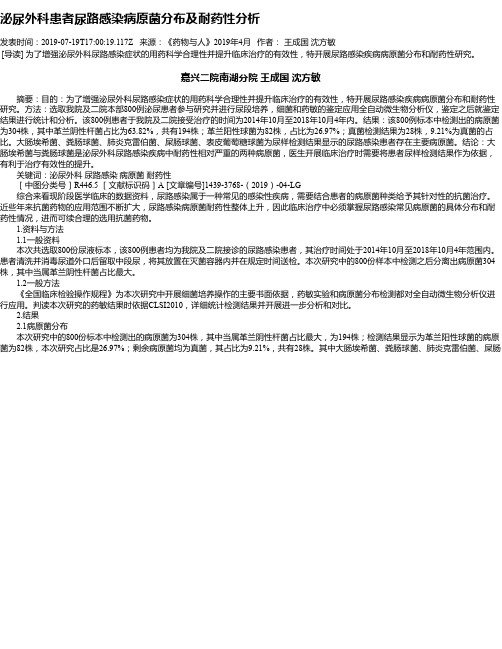
泌尿外科患者尿路感染病原菌分布及耐药性分析发表时间:2019-07-19T17:00:19.117Z 来源:《药物与人》2019年4月作者:王成国沈方敏[导读] 为了增强泌尿外科尿路感染症状的用药科学合理性并提升临床治疗的有效性,特开展尿路感染疾病病原菌分布和耐药性研究。
嘉兴二院南湖分院王成国沈方敏摘要:目的:为了增强泌尿外科尿路感染症状的用药科学合理性并提升临床治疗的有效性,特开展尿路感染疾病病原菌分布和耐药性研究。
方法:选取我院及二院本部800例泌尿患者参与研究并进行尿段培养,细菌和药敏的鉴定应用全自动微生物分析仪,鉴定之后就鉴定结果进行统计和分析。
该800例患者于我院及二院接受治疗的时间为2014年10月至2018年10月4年内。
结果:该800例标本中检测出的病原菌为304株,其中革兰阴性杆菌占比为63.82%,共有194株;革兰阳性球菌为82株,占比为26.97%;真菌检测结果为28株,9.21%为真菌的占比。
大肠埃希菌、粪肠球菌、肺炎克雷伯菌、屎肠球菌、表皮葡萄糖球菌为尿样检测结果显示的尿路感染患者存在主要病原菌。
结论:大肠埃希菌与粪肠球菌是泌尿外科尿路感染疾病中耐药性相对严重的两种病原菌,医生开展临床治疗时需要将患者尿样检测结果作为依据,有利于治疗有效性的提升。
关键词:泌尿外科尿路感染病原菌耐药性[中图分类号]R446.5 [文献标识码]A [文章编号]1439-3768-(2019)-04-LG综合来看现阶段医学临床的数据资料,尿路感染属于一种常见的感染性疾病,需要结合患者的病原菌种类给予其针对性的抗菌治疗。
近些年来抗菌药物的应用范围不断扩大,尿路感染病原菌耐药性整体上升,因此临床治疗中必须掌握尿路感染常见病原菌的具体分布和耐药性情况,进而可续合理的选用抗菌药物。
1.资料与方法1.1一般资料本次共选取800份尿液标本,该800例患者均为我院及二院接诊的尿路感染患者,其治疗时间处于2014年10月至2018年10月4年范围内。
298株尿液培养的细菌分布及耐药分析

298株尿液培养的细菌分布及耐药分析于花;刘敏;史顺;冯笑梅【摘要】目的探讨泌尿系统感染病原菌分布及耐药状况。
方法对尿液标本进行菌种鉴定和药敏试验。
结果检出的298株病原菌中,革兰阴性杆菌209株(70.13%),革兰阳性球菌54株(18.12%);真菌35株(11.75%)。
大肠埃希菌、肺炎克雷伯菌,产超广谱β-内酰胺酶(ESBLs)的检出率分别为58.70%和65.00%。
屎肠球菌对万古霉素敏感。
结论泌尿系感染病原菌分布广泛,以大肠埃希菌为主,且耐药趋势日趋严重,临床需加强抗生素的合理用药。
【期刊名称】《临床检验杂志(电子版)》【年(卷),期】2018(007)003【总页数】1页(P400-400)【关键词】泌尿系统感染;病原菌;耐药分析;抗生素【作者】于花;刘敏;史顺;冯笑梅【作者单位】[1]内蒙古国际蒙医医院临床检验中心,内蒙古呼和浩特010065;;[1]内蒙古国际蒙医医院临床检验中心,内蒙古呼和浩特010065;;[1]内蒙古国际蒙医医院临床检验中心,内蒙古呼和浩特010065;;[1]内蒙古国际蒙医医院临床检验中心,内蒙古呼和浩特010065;【正文语种】中文【中图分类】R378泌尿系统感染是临床常见感染性疾病之一,细菌是引起泌尿系统感染最常见的病原菌。
随着抗菌药物的广泛使用以及尿管留置术等各种介入性的诊断及治疗因素的影响,尿路感染的发病率不断增高,耐药菌株的检出率也不断上升,直接影响泌尿系统感染的治疗效果[1]。
为了了解本院泌尿系统感染病原菌分布及其药敏试验结果,本文收集了2012年7月-2015年9月住院和门诊泌尿道感染患者尿标本进行了菌种鉴定和药敏试验,现报告如下。
1 资料与方法1.1 菌株来源所有菌株均来自本院2012年7月-2015年9月门诊及住院患者送检的尿培养阳性标本。
1.2 培养基及鉴定药敏板哥伦比亚血平板、麦康凯平板为法国梅里埃生物制品有限公司产品,鉴定及药敏复合板为德国西门子公司产品。
导尿管相关尿路感染生物被膜菌及药敏结果分析

导尿管相关尿路感染生物被膜菌及药敏结果分析潘志雄;刘晓峰;郎梅春;刘丹;陈越【摘要】目的了解九江地区近2年来导尿管插管后患者尿路感染的病原菌构成,细菌耐药性和生物被膜形成情况,以便指导临床合理用药.方法于2009年8月至2011年8月选择我院住院部收治的CAUTI患者145例为对象,对其导尿管进行细菌培养,药敏试验和细菌生物被膜的检测.结果共分离出118株生物被膜菌,检出率81.4%;以大肠埃希菌为主,占46.61%;大多数生物被膜菌株有较厚的生物被膜;革兰阴性菌中大肠埃希菌等对β-内酰胺类抗生素有很高的耐药率,对阿米卡星的耐药率较低,大肠埃希菌和肺炎克雷伯菌对亚胺培南敏感率为100%.革兰阳性球菌的耐药情况也相当严重.结论针对大多数生物被膜菌株有较厚的生物被膜,要选择细菌生物被膜敏感的抗菌药物,根据菌株的药敏试验,合理地制定治疗方案,以便控制感染.【期刊名称】《实验与检验医学》【年(卷),期】2012(030)001【总页数】3页(P27-29)【关键词】导尿管相关性尿路感染;生物被膜;半定量分析【作者】潘志雄;刘晓峰;郎梅春;刘丹;陈越【作者单位】江西省九江市第一人民医院检验科,江西九江332000;江西省九江市第一人民医院检验科,江西九江332000;江西省九江市第三人民医院检验科,江西九江332000;江西省九江市第一人民医院检验科,江西九江332000;江西省九江市第一人民医院检验科,江西九江332000【正文语种】中文【中图分类】R446.5;Q939.92尿路感染是常见的医院感染,在20世纪90年代仅次于呼吸道感染的感染性疾病,占医院感染的第二位[1]。
在尿路感染的病例中有75%~80%是留置导尿管所引起,称导尿管相关性尿路感染(CAUTI)。
极易造成医院获得性感染,而CAUTI难治又易于复发与生物被膜形成有关。
随着形成生物被膜菌引发医院感染率的增加,对其的关注程度也在加大,本研究收集2009年8月至2011年8月住院导尿管插管患者感染病例,对病原菌的种类、生物被膜的形成和药敏结果进行回顾性分析,旨在为临床医生了解本地区导尿管相关性尿路感染菌的生物被膜形成情况及其耐药特性,以便合理选择抗生素进行抗感染治疗。
留置导尿管患者尿路感染病原菌分布及其耐药性分析

留置导尿管患者尿路感染病原菌分布及其耐药性分析豆金成;邓荣界;王荣学【期刊名称】《临床合理用药杂志》【年(卷),期】2018(11)24【摘要】目的分析留置导尿管患者尿路感染病原菌分布情况及其耐药性,为抗菌药物合理使用提供指导。
方法选取昭通市中医医院2016年3月—2017年6月收治的留置导尿管患者144例,取尿液做细菌培养,分析病原菌分布,并采用Kirby-Bauer 琼脂扩散法进行药敏试验,对药敏试验结果进行分析。
结果各时间组细菌培养阳性率比较,差异有统计学意义(P<0.05)。
144例留置导尿管患者尿液标本中分离出病原菌45株,阳性率为31.25%(45/144),其中大肠埃希菌占44.44%,肺炎克雷伯菌占13.33%。
大肠埃希菌对头孢曲松、环丙沙星、左氧氟沙星耐药率较高,对丁胺卡那霉素、替加环素、亚胺培南耐药率低;肺炎克雷伯菌对头孢曲松、复方新诺明耐药率较高,对丁胺卡那霉素、替加环素、亚胺培南耐药率低;肠球菌属对克林霉素、青霉素、左氧氟沙星、莫西沙星、环丙沙星耐药率较高,对万古霉素、利奈唑胺、呋喃妥因耐药率低;葡萄球菌属对青霉素、克林霉素、左氧氟沙星、环丙沙星、庆大霉素耐药率高,对利奈唑胺耐药率低。
结论随着导尿管留置时间的延长,尿路感染阳性率逐渐升高。
留置导尿管患者尿路感染病原菌以大肠埃希菌、肺炎克雷伯菌、肠球菌属、葡萄球菌属为主,且对多种抗菌药物耐药。
因此,临床应以杀灭以上病原菌为主,加强耐药性检测,选择合适的抗菌药物。
【总页数】2页(P82-83)【作者】豆金成;邓荣界;王荣学【作者单位】云南省昭通市中医医院检验科【正文语种】中文【中图分类】R472【相关文献】1.留置导尿管截瘫患者尿路感染病原菌分布及耐药性分析2.小儿患者留置导尿管致尿路感染病原菌分布及耐药性分析3.留置导尿管患者尿液病原菌分布及耐药性分析4.留置导尿管致尿路感染病原菌分布及药物敏感分析5.留置导尿管致尿路感染病原菌分布及耐药性分析因版权原因,仅展示原文概要,查看原文内容请购买。
导尿管伴随性尿路感染生物被膜阳性菌分布及耐药性分析

导尿管伴随性尿路感染生物被膜阳性菌分布及耐药性分析谭志军;谢惠芳;唐勇华【期刊名称】《临床和实验医学杂志》【年(卷),期】2009(008)008【摘要】目的了解导尿管伴随性尿路感染中生物被膜阳性菌的类型及其对常用抗菌药物的耐药情况,指导临床合理用药.以便于采取易行实用的预防对策,降低医院感染的发生率.方法收集2007年1月至2008年12月在祁阳县人民医院给以尿道插管的住院病人导尿管标本进行无菌采集,对其行一系列处理筛查生物被膜阳性菌,用全自动微生物鉴定系统VlTEK-32进行细菌鉴定及用纸片(K-B)法对其进行药敏试验分析.结果共收集导尿管标本220例,其中确诊为尿路感染的标本为132例,感染率为60.0%,生物被膜阳性菌78株,阳性率达35.5%.分别是:7株铜绿假单胞菌;24株粪肠球菌;29株表皮葡萄球菌;18株溶血葡萄球菌.结论导尿管伴随性尿路感染中表皮葡萄球菌、粪肠球菌易形成生物被膜,且耐药情况严重.生物被膜菌组与浮游菌组比较,药敏分析有差异,生物被膜组细菌耐药性更强.【总页数】3页(P44-46)【作者】谭志军;谢惠芳;唐勇华【作者单位】祁阳县人民医院,湖南,祁阳,426100;祁阳县人民医院,湖南,祁阳,426100;祁阳县人民医院,湖南,祁阳,426100【正文语种】中文【中图分类】R6【相关文献】1.尿路感染生物被膜菌临床分布及耐药性研究 [J], 邹彬彬;漆涌;伍勇2.导尿管伴随尿路感染的菌群及其耐药性分析 [J], 虞海峰;陈映鹤;竺海波;何有华;张磊;陈志勇;饶大庞;杨世坤;余凯远3.泌尿外科导尿管与非导尿管相关性尿路感染病原菌分布及耐药性比较 [J], 谢朝云;熊芸;孙静;杨忠玲;胡阳;杨怀4.导尿管伴随尿路感染菌群分布及耐药性分析 [J], 毕海波;方芳;刘新;张春阳5.导尿管伴随性尿路感染患者感染生物被膜菌及药敏分析 [J], 周淑群;周定球;刘滨因版权原因,仅展示原文概要,查看原文内容请购买。
医院内泌尿道感染患者的病原菌耐药性分析

医院内泌尿道感染患者的病原菌耐药性分析严威;靳情【期刊名称】《医学信息》【年(卷),期】2018(031)011【摘要】目的了解湖北省襄阳市第一人民医院住院患者泌尿系感染的主要病原菌分布与抗生素对常用菌的耐药率.方法回顾性收集湖北省襄阳市第一人民医院2017年1月~12月住院患者1580份尿培养样本,采用全自动微生物鉴定仪480份阳性标本进行鉴定及药敏试验.应用WHONET5.6对数据进行分析.结果 480株病原菌中,革兰阴性杆菌353株(73.54%),以大肠埃希菌、肺炎克雷伯菌和铜绿假单胞菌为主;革兰阳性球菌85株占(17.71%),以肠球菌和凝固酶阴性葡萄球菌为主;真菌40株(8.33%).检出的病原菌对各种抗生素的耐药率不同,所有分离的大肠埃希菌与肺炎克雷伯菌对三代头孢菌素和喹诺酮类耐药率均大于50%,并且外科系统分离的大肠埃希菌株耐药率高于内科系统;铜绿假单胞菌对β 内酰胺酶抑制剂耐药率大于30%,高于其他病原菌对此类抗生素耐药率.未发现分离的革兰阳性菌对万古霉素和利奈唑胺耐药,凝固酶阴性葡萄球菌对苯唑西林耐药率达82.60%.结论本院泌尿系统感染中,以大肠埃希菌感染为主,β 内酰胺酶抑制剂可用于大肠埃希菌和肺炎克雷伯菌常规治疗.【总页数】3页(P118-120)【作者】严威;靳情【作者单位】湖北医药大学附属襄阳市第一人民医院输血科,湖北襄阳 441000;湖北中医药大学附属襄阳市中医医院检验科,湖北襄阳 441000【正文语种】中文【中图分类】R446.5【相关文献】1.泌尿道感染患者尿培养病原菌分布及耐药性分析 [J], 王艳艳;王俊瑞;郭素芳;福泉;周鹿蕾;范文兵;韩艳秋2.1500例泌尿道感染患者病原菌检测及耐药性分析 [J], 徐隽;高波3.中医院肾病科泌尿道感染患者病原菌分布及耐药性分析 [J], 刘光忠;倪维;杨柳;肖明中4.贫困山区脑卒中并泌尿道感染患者病原菌分布及耐药性分析 [J], 散兴忠;林森;许世伟5.颅脑外伤合并泌尿道感染患者的病原菌分布及耐药性分析 [J], 曾贤铭;孙青阳;于婷婷;卢旺娣;张婴嫱因版权原因,仅展示原文概要,查看原文内容请购买。
停留导尿管致尿路感染病原菌分布及耐药性分析

停留导尿管致尿路感染病原菌分布及耐药性分析
李如职
【期刊名称】《广州医学院学报》
【年(卷),期】2005(33)3
【摘要】目的:了解导尿管伴随尿道感染(Utlc)的原菌谱及对常用抗菌药物的敏感性.方法:对2001年1月至2003年1月间留置导尿管引起尿路感染患者尿液行细菌学培养,分离的病原菌以kirby-Bauer琼脂扩散法药敏试验.结果:留置导尿管病人2 071例尿液标本分离的病原菌535株,阳性率25.8%.其中以革兰氏阴性细菌为主,约占65%;大肠杆菌、痢疾杆菌、不动杆菌及克雷白氏菌属占前4位.第三代头孢菌素对革兰氏阴性或阳性菌敏感率明显优于第一和二代头孢菌素,喹诺酮类也有较好的效果.结论:留置导尿管致尿道感染以革兰氏阴性菌为主,出现多重耐药,抗生素应交叉使用,必要时联合应用.
【总页数】2页(P55-56)
【作者】李如职
【作者单位】佛山市南海区西樵人民医院,广东,佛山,528211
【正文语种】中文
【中图分类】R195.4
【相关文献】
1.重症监护病房导尿管相关性尿路感染病原菌的分布及其耐药性分析 [J], 邓冲
2.导尿管相关性尿路感染病原菌分布及耐药性分析 [J], 廖一群;江丽霞
3.留置导尿管截瘫患者尿路感染病原菌分布及耐药性分析 [J], 孙秀丽
4.小儿患者留置导尿管致尿路感染病原菌分布及耐药性分析 [J], 杨小苏;于力;胡小娟
5.留置导尿管致尿路感染病原菌分布及耐药性分析 [J], 钟惟德;蔡岳斌;胡建波;王良圣;魏鸿蔼
因版权原因,仅展示原文概要,查看原文内容请购买。
- 1、下载文档前请自行甄别文档内容的完整性,平台不提供额外的编辑、内容补充、找答案等附加服务。
- 2、"仅部分预览"的文档,不可在线预览部分如存在完整性等问题,可反馈申请退款(可完整预览的文档不适用该条件!)。
- 3、如文档侵犯您的权益,请联系客服反馈,我们会尽快为您处理(人工客服工作时间:9:00-18:30)。
402160)
DOI:10.3969/j.issn.2095-4344.2267
ORCID: 0000-0001-9204-7321(1)研究发现输尿管支架表面细菌生物膜的形成在导管相关性尿路感染中起着重要作用,细菌黏附在 输尿管支架形成生物膜后具有很强的耐药性;
(2)全面分析输尿管支架表面细菌生物膜的形态学特点、病原菌费分布和耐药性。
Zhang Jiamo, Master, Attending physician, Department of Urology, Yongchuan Hospital, Chongqing Medical University, Chongqing 402160, China
2556
ZHANG JM, ZHANG X, LUO HM, ZHAO T, CHEN JC, LIU J, WANG K. Pathogenic distribution and drug resistance of bacterial biofilm on ureteral stent. Zhongguo Zuzhi Gongcheng Yanjiu. 2020;24(16):2556-2560. DOI:10.3969/j.issn.2095-4344.2267
Abstract BACKGROUND: Ureteral stents have been extensively applied in the stenosis in the conjunction of the renal pelvis and ureter, the reconstruction of in situ urine flow, ureter or nephroscope lithotripsy, renal transplant, and tumors. However, the long-term retention of ureteral stents can induce catheter-associated urinary tract infection complications. OBJECTIVE: To investigate the morphological characteristics of bacterial biofilm on ureteral stent, and to analyze the features of pathogenic distribution and antimicrobial drug resistance to bacterial biofilm. METHODS: Specimens of ureteral stent were collected from 127 patients at Yongchuan Hospital, Chongqing Medical University between January and December 2016. The morphological characteristics of bacterial biofilm on the stent were observed under scanning electron microscope. Each specimen was divided into three parts (renal pelvis, ureter and bladder) for screening biofilm-forming bacteria strains separately by Congo red medium. The urine was bacterially cultured. Drug susceptibility test was done with the collected biofilm-forming bacteria strains. The study was approved by the Ethics Committee of Yongchuan Hospital, Chongqing Medical University (approval No. 201422). RESULTS AND CONCLUSION: (1) Bacterial biofilm was observed on the surface of ureteral stents at 7, 15 and 30 days of retention, with various numbers of inflammatory attachments or crystals. Bacteria on the bacterial biofilm were embraced by large amounts of fiber membranes. Patchy bacterial colonies were observed on the surface of the ureteral stent at 7 and 15 days of retention, which mainly focused on bacillus. Heap-shaped bacterial colonies were found on the surface of ureteral stents that were retained for 30 days, which mainly were bacillus and coccus. (2) A total of 106 bacterial biofilms were detected in the ureteral stent samples obtained from 127 patients. The positive rate was 83.5%, in which the bladder section had the highest positive rate, followed by the renal pelvis section and ureter section. There were 25 copies of positive urine culture, and the positive rate was 19.7%. The strains obtained from the bacterial biofilm on each section of the ureteral stents were significantly higher than that from the urine bacteria culture (P < 0.05). (3) A total of 227 strains were detected from 106 positive samples. Among these samples, the number of Gram-negative strains was significantly higher than that of Gram-positive strains (P < 0.05). Among culture bacteria of the bacterial biofilm on the ureteral stent and urine culture bacteria, colibacillus, pseudomonas aeruginosa, enterococcus faecalis and enterococcus faecium were the most common. (4) The biofilm-forming bacteria on the ureteral stent had a high drug resistance. (5) In summary, bacterial biofilm may be the important reason for catheter-associated urinary tract infection. Key words: bacterial biofilm; ureteral stent; catheter-associated urinary tract infection; drug resistance; nosocomial infections; urine culture; colibacillus; pseudomonas aeruginosa Funding: the Medical Research Project of Health and Family Planning Commission of Chongqing, No. 20142062 (to ZJM)
Pathogenic distribution and drug resistance of bacterial biofilm on ureteral stent
Zhang Jiamo1, Zhang Xuan1, Luo Huaming1, Zhao Tao1, Chen Jiangchuan1, Liu Juan2, Wang Ke3 (1Department of Urology, 2Department of Pharmacy, 3Department of Laboratory Medicine, Yongchuan Hospital, Chongqing Medical University, Chongqing 402160, China)
扫描电镜:
结论:
获取 127 例 患者的输尿 管支架标本
观察支架表面细菌生物膜的形态学特征; 刚果红培养基:
筛选肾盂段、输尿管段和膀胱段支架的细 菌生物膜菌株;
输尿管支架细菌 生物膜是诱发导 管相关性尿路感 染的重要因素。
尿培养:
对检出的病原菌进行药敏试验分析。
张家模,男,1982 年生, 重庆市人,汉族,硕士, 主治医师,主要从事泌尿 系结石微创治疗方面的研 究。
《中国组织工程研究》 Chinese Journal of Tissue Engineering Research
